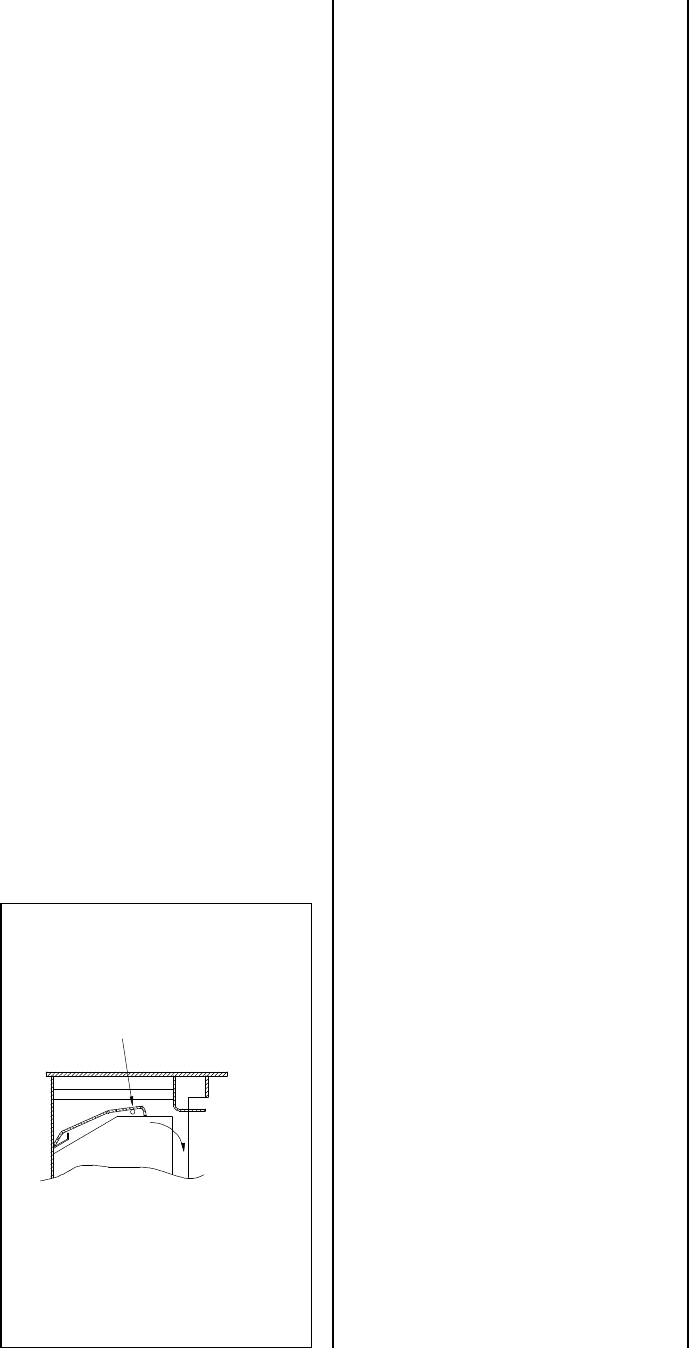
open for long periods as this can cause
over-firing. For overnight burning they
should be closed.
The airwash control is used most of the
time to control the burning rate and to
keep the glass clean. Fully extended gives
full airwash for faster burning and clean
glass whereas fully closed gives slow
overnight burning. It will not be possible
to keep the glass clean if this control is
fully closed, particularly just after
refuelling.
REFUELLING
Keep the firebox well filled but do not
allow fuel to spill over the top of the
front fire bars.
Care should be taken, especially when
burning wood, that fuel does not project
over the front fire bars or damage to the
glass may be caused when the doors are
closed, it can also cause the glass to black
up.
ASH CLEARANCE
When burning wood or peat the ash
should be allowed to build up on the base
of the fire. It will only be necessary to
remove some ash once or twice a week
when it begins to restrict the flow of air
through the front fence.
When burning coal or smokeless fuel the
ashpan should be emptied regularly
before it becomes too full, generally once
or twice a day. Never allow the ash to
accumulate in the ashpan so that it comes
in contact with the underside of the grate
as this will seriously damage the grate.
Care should be taken to ensure that ash is
cool before emptying it into plastic liners
or bins. After emptying the ashpan, poke
the fire with a poker to clear the firebed
of ash.
To make ash removal easier, when
burning coal or smokeless fuel, there is a
special Charnwood ash carrier available.
This enables the whole ashpan to be
placed in the sealed carrier and taken
outside. These may be purchased from
your supplier or, in case of difficulty,
from ourselves.
SPECIAL POINTS WHEN
BURNING HOUSE COAL
When loading the stove take care not to
smother the fire, instead fill the firebox
in two stages waiting between each stage
for the flames to appear above the fire.
After a period of slumbering always open
the door air slides and wait until flames
appear above the fuel bed before opening
the doors.
Burning coal will produce more soot
deposits than other fuels, especially if the
fire is run at low levels for long periods.
It is therefore vital to clean the throat
plate regularly, weekly cleaning is
recommended.
Never fully close the Airwash control
when burning coal.
RUNNING THE FIRE WITH
THE DOORS OPEN
The fire may be run with the doors open
if required. The more reactive fuels, such
as wood, peat, coal and homefire, will
burn better with the doors open than fuels
like phurnacite and ancit. Do not leave
the fire unattended with the doors open.
OVERNIGHT BURNING
For overnight burning the fire doors must
be closed.
When burning wood load some large logs
on the fire and allow to burn for half an
hour before closing the door air slides,
(this will help to reduce tar deposits in
the chimney.) Leave the airwash control
slightly open to help keep the glass clear.
When burning coal or smokeless fuel, if
the fire is very low then open the air
controls and revive the fire, adding a
small amount of fuel if necessary. Empty
the ashpan and poke the fire, load with
fuel, and then close the door air slides.
The airwash control should be kept
slightly open to help keep the door glass
clean.
Some experimentation may be necessary
to find the setting most suitable for the
type of fuel being used and the draw on
the chimney.
To revive the fire, empty the ashpan, (if
burning coal or smokeless fuel), poke the
fire, and open the air controls to
maximum. When the fire is burning well
load on more fuel as necessary and adjust
the air controls to the desired setting.
CLEANING AND
MAINTENANCE
The stove is finished with a high
temperature paint which will withstand
the temperatures encountered in normal
use. This may be cleaned with a damp
lint-free cloth when the stove is cold.
Should re-painting become necessary,
high temperature paints are available
from your supplier or from stove shops.
Most deposits on the glass may be burnt
off simply by running the fire at a fast
rate for a few minutes. If it becomes
necessary to clean the glass then open the
doors and allow them to cool. Clean the
glass using a damp cloth and then wiping
over with a dry cloth. Any stubborn
deposits on the glass may be removed
with a proprietary stove glass cleaner or
ceramic hob cleaner. Do not use abrasive
cleaners or pads as theses can scratch the
surface which will weaken the glass and
cause premature failure.
THROAT PLATE AND
FLUEWAY CLEANING
It is important that the throat plate and all
the stove flueways are kept clean in order
to prevent potentially dangerous fume
emission. They should be cleaned at least
monthly, and more frequently if
necessary. It is not necessary to let the
fire out completely to carry out these
operations.
The front of the throat plate is pulled
forward and then lowered as shown in
Fig. 2. Any sooty deposits should then be
and Lowering.
Fig. 2. Throat Plate Position
Throat Plate
Pull Forward
and Swing Down
Page 3
Country 8 &12 WB 6/97









